Dubai and conservation are not two words you would expect to hear together; and yet there is a remote and hidden desert gem just 40 minutes from the bustling city centre.
Its ears are enormous. Its look is one of a deer caught in the headlights – wide-eyed, frightened and confused. It is an extremely rare sand fox and it has gone into the Dubai Desert Conservation Reserve (DDCR). Dubai and conservation? Really? Those two words don’t usually go together in most people’s minds.
I decided to join the Dubai Desert Conservation Reserve on a volunteering expedition with Biosphere Expeditions – a non-profit conservation organisation, helping Steve Bell and Greg Simkins, two South African biologists, gathering data on Dubai’s desert wildlife – Arabian oryx, Gordon’s wildcat, sand fox, sand and mountain gazelles, birds, reptiles and more. All these animals exist, and some thrive, in this seemingly endless sea of sand dunes, stretching to the horizon in wave after wave of orange and gold. It is just 40 minutes from the city centre and after you peel off the busy motorway, tranquillity rules. The gates open and turtle doves sing above the sound of the wind, sand drifts across the asphalt, which soon runs out into the sandy sea, turning into a road back in time and into another world. An Arabia before the advent of firearms, before oil was discovered, before commerce turned the United Arab Emirates into a country of big money, cars, skyscrapers, shopping malls and fast food outlets. In this old Arabia, the desert and its wildlife rule. As we drive down the track, I am reminded of Africa. An oryx stands majestically on the crest of a sandy wave, gleaming white above the orange sand and against the clear blue sky. With his long slender horns and graceful outline, he is calmness personified and a quintessential Arabian image, gone now from the rest of the peninsula, hunted to extinction in all but protected and fenced. Gazelles are not so calm as they dash across the road, sprinting as if their lives depended on getting into the safety of the sandy sea that is their home. Vultures circle overhead, soaring high on the desert’s thermals, drawing circles into the sky’s perfect blue. A spiny-tailed lizard rests in the shade of a bush, biding its time oblivious to the haven it is living in. Francolin game bird families dart along the track like headless chickens, trying to outrun the car when all they have to do is turn sideways away from it. When the car stops, they stop. When it moves, they run alongside it. Just like those silly guinea fowl in South Africa or Namibia. But this is not Africa. This is Arabia as it once was. This is the DDCR.
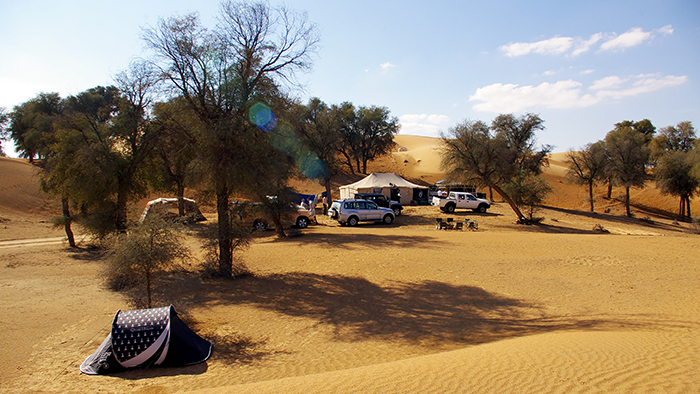
Conservation in this area started in 1999 when the Al Maha Desert Resort was opened within a protected area of 27 km² (Al Maha Reserve). One of the first conservation actions of the reserve was a wildlife reintroduction programme for Arabian oryx and the two indigenous gazelle species (sand and Arabian gazelle), as well as programmes for the protection of other key components of the ecosystem, in particular the vegetation (close to 6000 indigenous trees were planted in 1999 to create a natural seed bank, which has now led to germination of indigenous plants). In 2001 the resort management began a major environmental audit of the surrounding area. Following this audit a proposal was submitted to the Dubai government on the formation of a national park. The proposal was accepted and sanctioned almost immediately and work began on protecting the area.
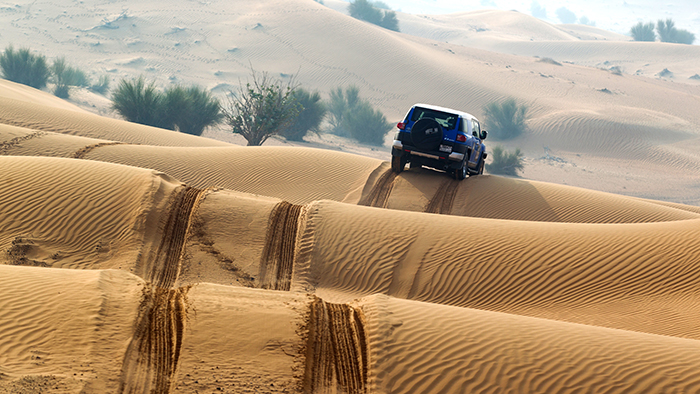
Today the DDCR conserves a habitat known as Dubai inland desert ecosystem – sand dunes interspersed with gravel plains. There is also one rocky outcrop in the north of the reserve, which provides nesting sites for the rare desert eagle owl and two groves of rare ghaf trees. There are now around 400 Arabian oryx from the 100 that were originally re-introduced in 1999. Both the Arabian oryx and the gazelle species have expanded into the DDCR naturally as the amount of human activity has decreased and been controlled. Estimated populations of approximately 300 mountain and 100 sand gazelle can now be seen throughout the DDCR.
Our expedition base is nestled between trees and dunes, in the middle of nowhere. At night there is perfect darkness except for a faint glow in the north. There is a large Bedu tent with a colourful interior featuring solar lighting, a shower and toilet block, a tented kitchen where a culinary wizard from Sri Lanka rules, and the dome tents that most of us volunteers sleep in. The expedition leader just sleeps outside on a dune in his sleeping bag. It gets cold at night, as you would expect in the desert, but then soon warms up as the sun rises over the sands. It’s January, so during the day it’s a very pleasant 20 to 30 degrees C – dry and breezy. Greg tells me that it’s so hot in the summer, that it’s virtually impossible to be outside. At temperatures approaching 50 degrees C and very high humidity, I have no doubt this is true and struggle even to imagine what that must feel like.
During the night we sleep in perfect tranquillity, with stars clear and bright as I have never seen them before and only the odd owl hoot and the crackle of the dying campfire embers to disturb the desert silence. During the day, our jobs are as varied as they are easily learnt. “The great thing about conservation biology is that much of it comprises tasks that are easily mastered,” Steve, our expedition scientist explains. “I need as many people on the ground to help me set live and camera traps, to check them, change batteries, to be my eyes and ears in the desert, recording species seen, their number and behaviour. There is no technology to do this for me. It’s down to good old manual labour to collect many pieces of a big puzzle that will help me and the DDCR to make important management decisions”. Steve’s eyes light up as he says this, gesticulating, and his love for the desert is obvious, as is his appreciation of our help. “And – in this most commercial of places – it’s just great to be able to share with like-minded people our passion for the environment and desire.” Soon Steve and Greg have won us over with their enthusiasm and we are eager students learning how to use binoculars and spotting scopes, a compass and map, how to set up and bait a live trap and do the same with its camera cousin, and last but not least, how to drive a 4×4 in the sand without getting stuck too often!
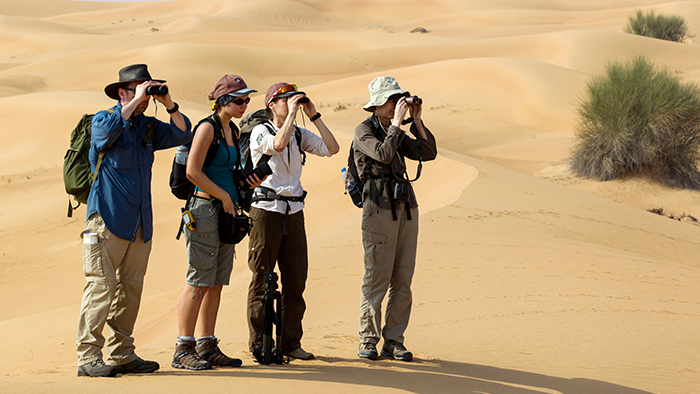
After a day and a half we are out in small teams to gather data for Steve and Greg. There’s the driving through the dunes, which is fun without the guilt of your usual tourist dune-bashing sojourn. Then we are sitting on the crest of a dune, the sun on our backs, observing a herd of oryx through our binoculars and spotting scopes. We look at fat layers to assess health; we record males, females and juveniles, their behaviour and feeding patters. Everything is meticulously recorded in a datasheet. “This is your reason to be here and your legacy. If you don’t fill this in properly, you may as well lie on a beach or go to one of the shopping malls downtown” were the expedition leader’s words. So we are meticulous and it is interesting to observe how the various nationalities work themselves into their respective roles. We are a very mixed team – a journalist from Australia, an Austrian expat from Dubai, a German health professional, a British accountant, a local wildlife enthusiast, an American psychologist with what in her country must be an unusual fascination with all things Arabic. But despite our different backgrounds and ages, we moulded into a team quickly, united by our common goals and interests in nature and wildlife.
With the oryx herd observed, we move on to place some camera traps and then check our live traps. Often they are empty, but with the sand fox we have hit the jackpot. Steve is elated. We sedate, measure, weigh and tag him and then let him escape back into the desert. We do the same with Gordon’s wildcats, another rare and threatened species, we capture. In that sense it is not Africa where habituated animals are best found where most safari vehicles congregate. This is a truly wild place without safari tourists and it is a real privilege to be so close to truly wild animals and to gain an insight into the work of experts and passionate people trying to conserve them. Steve and Greg are two of those people.
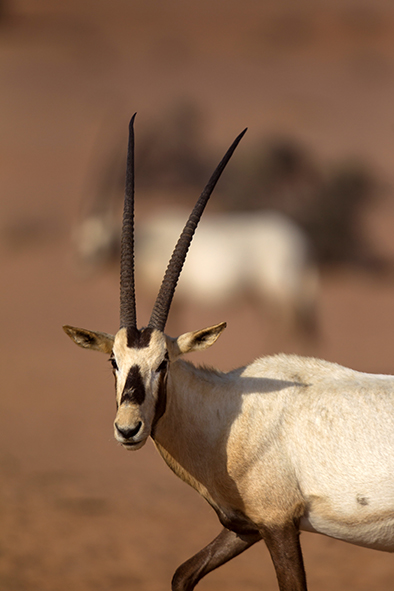
The Arabian oryx is the largest of the antelopes in the region and it is very well adapted to the extremely arid environment. Oryx once roamed all across Arabia, but firearms saw their rapid decline. Since 1986 the Arabian oryx is classified as “Endangered” on the IUCN Red List, but was already “very rare and believed to be rapidly decreasing in numbers” in 1965. The DDCR is a globally important refuge for the species.
The Gordon’s wildcat looks very similar to and is the same size as a domestic cat. Indeed, the biggest threat to the survival of the Gordon’s wildcat as a species is the interbreeding with feral or domestic cats, which could lead to its extinction as a distinct species. Very little is known about the Gordon’s wildcat population within the DDCR; the last population estimate was done in 2004 and we are here to update this.
The sand fox, also known as Rüpell’s fox, is a desert-adapted carnivore. Although it is in the IUCN category “Least Concern”, little is known about its habitat and ecology. This too is one thing the project is hoping to change.
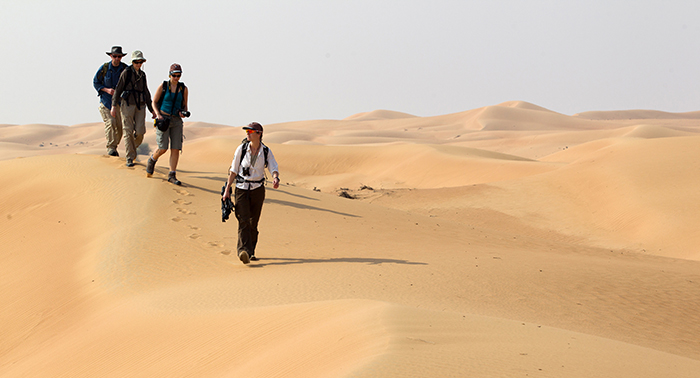
And finally, the sand and mountain gazelle are in IUCN categories Endangered and Vulnerable respectively. The population of mountain gazelle is believed to be a few hundred worldwide only. Major threats include illegal hunting for meat and live capture for pets and private collections. Habitat loss through agricultural development, fencing pasture for cattle, construction of roads and settlement is also a major threat.
With all this, we help and it feels good to do so. Like the little sand fox quickly disappearing off into the vastness of the desert after we have released it, it may be just a small thing in a sea of sand but despite us being only drops of help, Steve says “It is drops of rain that make creeks and rivers, lakes and oceans”.
Words By: Matthias Hammer
Photos By: Supplied

